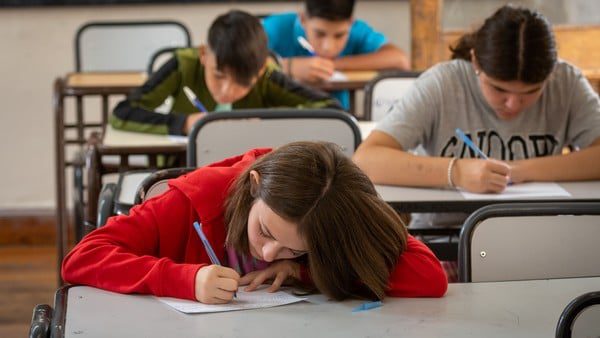Global Courant 2023-05-23 08:05:40
Since the 1990s, the provinces have been in charge of administering the schools. This means that three out of every four pesos that the State invests in education are done by the governors and the head of government of the City, who must pay salaries, repairs in schools or subsidies to private schools, among other matters.
In 2006, Congress passed the Educational Financing Law, which forced the State (Nation plus provinces) to invest 6% of GDP in education. Since then, that goal was reached in only two years (2013 and 2015).
When looking for those responsible for the low investment in education, they usually point to the national State that, indeed, had a fluctuation in its educational budgets. Now, what about the provinces, the main investor for the schools?
A study by the Argentine Observatory for Education focused on this behavior and found that, between 2004 and 2021 (latest data available), half of the districts -12 out of 24- reduced what is known as the “budget effort” in education . That is to say, the percentage that they put for the classrooms of the total cake of money that they have for each year. One of the indicators that receives the most attention when it comes to educational financing.
The greatest reductions occurred in CABA (-8.8 percentage points) and Mendoza (-7.3 pp), while Salta (+8.1) and Neuquén (+6.6) were the ones that increased it the most, shows the report by Javier Curcio (UBA/IIEP), Martín Nistal and Víctor Volman (Observatory of Argentines for Education).
The study considers the total educational expenditure in the provinces, regardless of which ministry executes it. According to this indicator, in 2021 the two jurisdictions that dedicated the highest proportion of their budget to education were Buenos Aires (30.8%) and Salta (28.8%). And those that allocated the least with respect to their total budget were CABA (16.7%) and Santa Cruz (17.6%). All the figures in the report are calculated at constant values for March 2023. In other words, without the distorting effect of inflation.
The responses of CABA and Mendoza
From the City of Buenos Aires they relativized the figures of the report and affirmed that, doing the accounts correctly, “in real terms the Education budget between 2007 and 2021 increased by 12%.”
To argue this, they said that the Observatory’s report counts co-participating funds as part of the “supposedly ‘jurisdictional’ effort” when “they are not and that is why Formosa and Catamarca appear to be making a greater effort.”
They also affirm that the City incorporated between 2004 and 2021 new powers that were transferred from the national government, such as the subway (since 2012), new powers in Justice, and the Security Service in 2016. “As an obvious consequence, the relative weights of all the distributions are reduced”, said the Buenos Aires government sources to Clarín.
And they added that, unlike the provinces, CABA finances both provincial and municipal powers. “If you wanted to compare the educational effort of CABA against the rest of the provinces, you would have to delete from the analysis the portions of the budget that CABA allocates to municipal powers. Thus, the share of education in total spending would rise considerably”, they say.
Finally, they affirm that investment in education should be analyzed based on educational results in areas such as infrastructure, technology, effective days/hours of class, internal efficiency rates of the system or the results of the Aprender test, where CABA takes advantage over others. provinces.
Clarín also spoke with Mendoza’s Education Minister José Thomas, who said that the percentage of education in that province in 2021 was actually 30% and not 22% as the report shows.
From Mendoza’s point of view, the Portezuelo del Viento project should not be added to the calculation of the total budget pie, which -like the subway in CABA- was recently transferred to the province by the Nation. In addition, they affirm, the percentage of the transport subsidy (because the jurisdiction transports the students) and the transfer that they make to municipalities should be included within the education function.
Like CABA, Thomas also focused on the educational results they obtain. For that, he showed a table that relates investment to the numbers of students who finish primary and secondary school on time, where Mendoza is well off.
“The resource matters, yes. But without a doubt, the politics you do also matters. And in that we are the most efficient province. In other words, if we had more money we could improve a lot. Today we are an orderly province, but we don’t have much more to share, ”he told this newspaper.
Almost everything goes to wages
The work of the Observatory also gets inside the provincial budgets and focuses on what each province spends on education. Although all the jurisdictions dedicate more than 65% of their educational budgets to the payment of salaries, this percentage reaches maximum levels in Chubut (91%) and Neuquén (86%). At the other extreme, those that allocate the lowest proportion of the educational budget to salaries are San Luis (66%), Formosa and CABA (69%).
The second priority (at least for 2021) are subsidies to private schools (12%) that -indirectly- also finance salaries. This implies that at the country level, 90% of educational expenses are used to pay salaries, says the Observatory report. The rest of the money goes to other expenses, like fixing up or building new schools.
“In a federal country, with financing shared between the Nation and the provinces, mechanisms must be considered so that the economic efforts of both levels of government are complementary and not substitutes and, likewise, the scarce resources are used in a way that combines the efficiency with equity between social strata and regions of the country,” says Juan Doberti, a professor and researcher at the UBA, in a statement from the Observatory.








